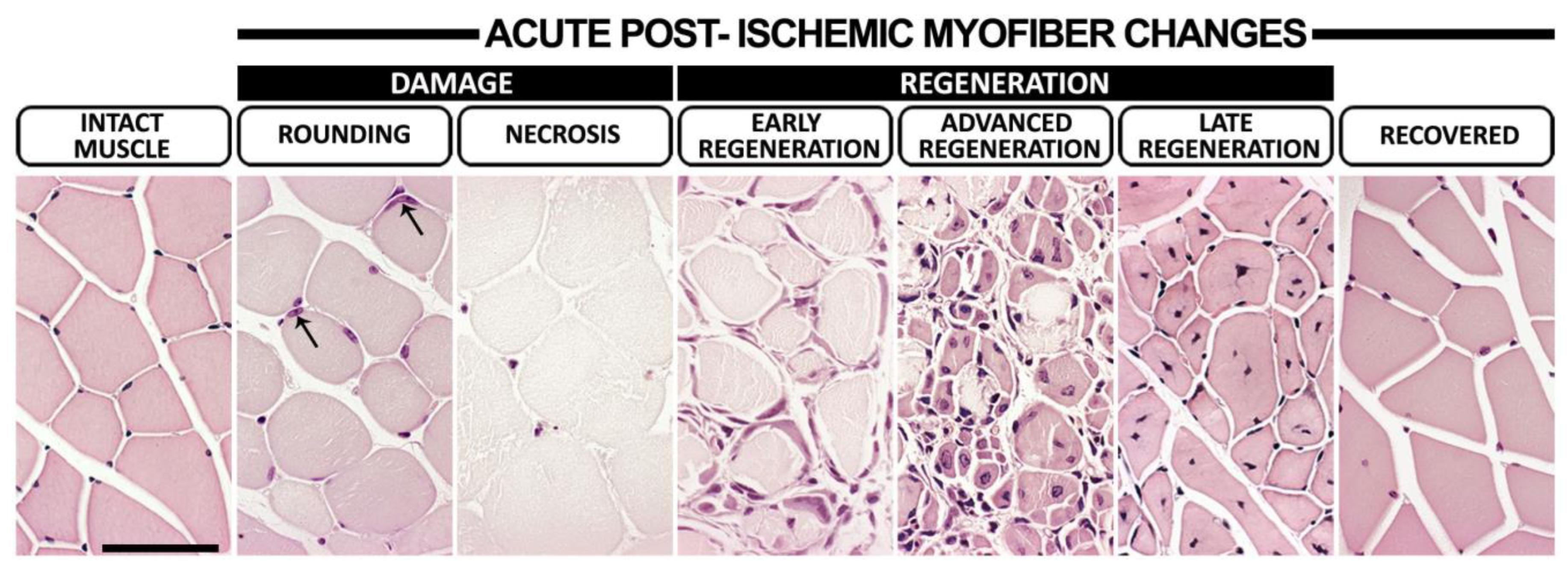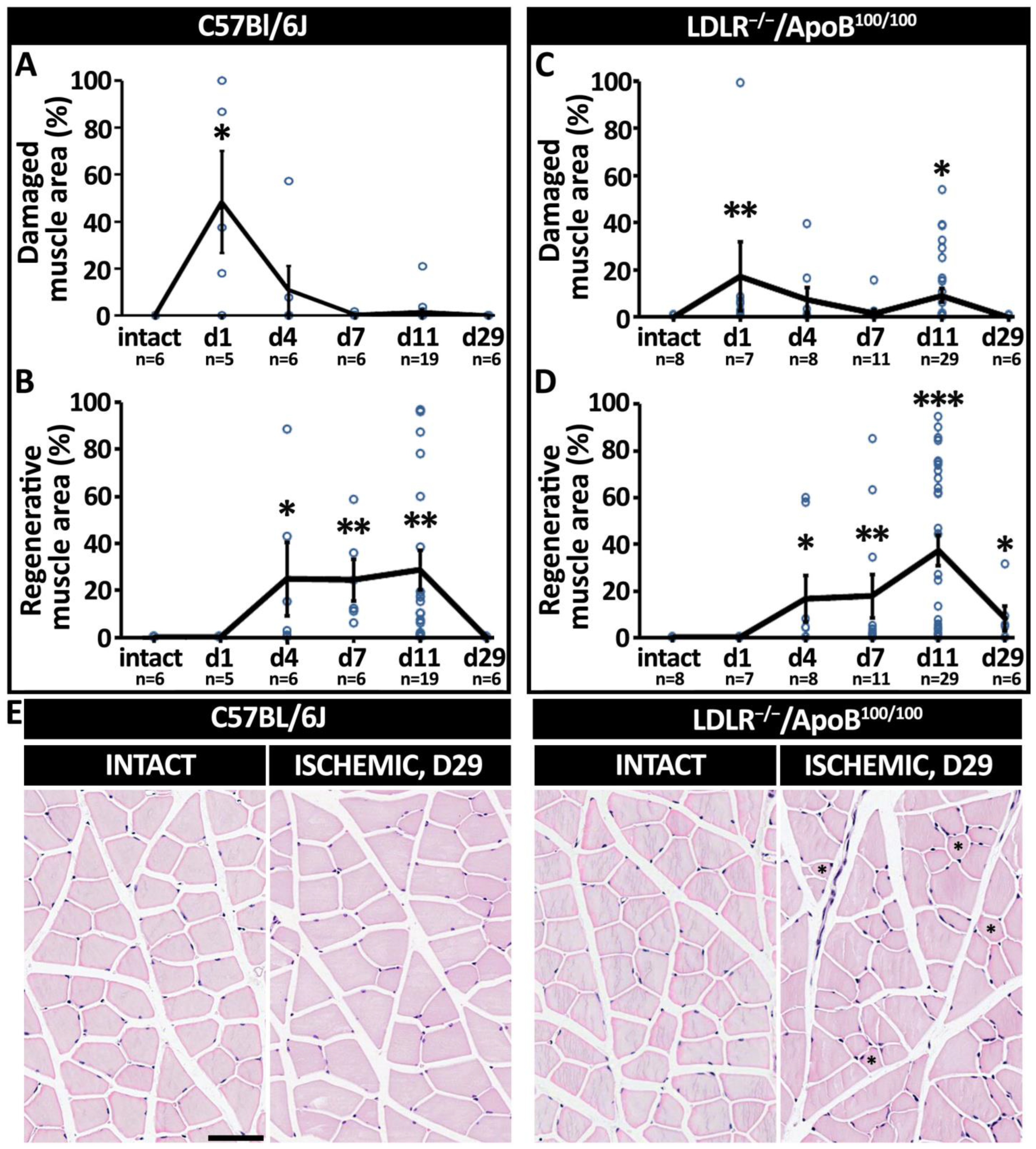Capillary Dynamics Regulate Post-Ischemic Muscle Damage and Regeneration in Experimental Hindlimb Ischemia
Abstract
1. Introduction
2. Materials and Methods
2.1. Experimental Animals
2.2. Contrast-Enhanced Ultrasound Imaging of Skeletal Muscle Perfusion
2.3. Photoacoustic Imaging of Microvascular Hemoglobin Oxygenation
2.4. Histological Approaches
2.5. Capillary Measurements
2.6. Statistical Analysis
3. Results
3.1. The “Favorable” and “Delayed” Patterns of Ischemic Damage and Regeneration
3.2. Skeletal Muscle Blood Flow Recovers under Decreased Arterial Driving Pressure
3.3. Oxygen Delivery and Its Tissue Demand Affect Post-Ischemic Microvascular Hemoglobin Oxygenation
3.4. Initial Capillary Enlargement Launches a Cascade of Post-Ischemic Microvascular Changes That Lead to Increased Capillary Density in C57Bl/6J but Not in LDLR−/−/ApoB100/100 Mice
4. Discussion
5. Conclusions
Author Contributions
Funding
Institutional Review Board Statement
Data Availability Statement
Acknowledgments
Conflicts of Interest
References
- Scholz, D.; Ziegelhoeffer, T.; Helisch, A.; Wagner, S.; Friedrich, C.; Podzuweit, T.; Schaper, W. Contribution of Arteriogenesis and Angiogenesis to Postocclusive Hindlimb Perfusion in Mice. J. Mol. Cell. Cardiol. 2002, 34, 775–787. [Google Scholar] [CrossRef] [PubMed]
- Schaper, W. Collateral Circulation. Past and Present. Basic Res. Cardiol. 2009, 104, 5–21. [Google Scholar] [CrossRef] [PubMed]
- Silvestre, J.S.; Smadja, D.M.; Lévy, B.I. Postischemic Revascularization: From Cellular and Molecular Mechanisms to Clinical Applications. Physiol. Rev. 2013, 93, 1743–1802. [Google Scholar] [CrossRef]
- Scholz, D.; Thomas, S.; Sass, S.; Podzuweit, T. Angiogenesis and Myogenesis as Two Facets of Inflammatory Post-Ischemic Tissue Regeneration. Mol. Cell. Biochem. 2003, 246, 57–67. [Google Scholar] [CrossRef] [PubMed]
- Dragneva, G.; Korpisalo, P.; Yla-Herttuala, S. Promoting Blood Vessel Growth in Ischemic Diseases: Challenges in Translating Preclinical Potential into Clinical Success. DMM Dis. Model. Mech. 2013, 6, 312–322. [Google Scholar] [CrossRef]
- Chiristov, C.; Chrétien, F.; Abou-Khalil, R.; Bassez, G.; Vallet, G.; Authier, F.J.; Bassaglia, Y.; Shinin, V.; Tajbakhsh, S.; Chazaud, B.; et al. Muscle Satellite Cells and Endothelial Cells: Close Neighbors and Privileged Partners. Mol. Biol. Cell 2007, 18, 1397–1409. [Google Scholar] [CrossRef]
- Verma, M.; Asakura, Y.; Murakonda, B.S.R.; Pengo, T.; Latroche, C.; Chazaud, B.; McLoon, L.K.; Asakura, A. Muscle Satellite Cell Cross-Talk with a Vascular Niche Maintains Quiescence via VEGF and Notch Signaling. Cell Stem Cell 2018, 23, 530–543.e9. [Google Scholar] [CrossRef]
- Rivard, A.; Fabre, J.E.; Silver, M.; Chen, D.; Murohara, T.; Kearney, M.; Magner, M.; Asahara, T.; Isner, J.M. Age-Dependent Impairment of Angiogenesis. Circulation 1999, 99, 111–120. [Google Scholar] [CrossRef]
- Tirziu, D.; Moodie, K.L.; Zhuang, Z.W.; Singer, K.; Helisch, A.; Dunn, J.F.; Li, W.; Singh, J.; Simons, M. Delayed Arteriogenesis in Hypercholesterolemic Mice. Circulation 2005, 112, 2501–2509. [Google Scholar] [CrossRef]
- Ungvari, Z.; Tarantini, S.; Kiss, T.; Wren, J.D.; Giles, C.B.; Griffin, C.T.; Murfee, W.L.; Pacher, P.; Csiszar, A. Endothelial Dysfunction and Angiogenesis Impairment in the Ageing Vasculature. Nat. Rev. Cardiol. 2018, 15, 555–565. [Google Scholar] [CrossRef]
- Véniant, M.M.; Zlot, C.H.; Walzem, R.L.; Pierotti, V.; Driscoll, R.; Dichek, D.; Herz, J.; Young, S.G. Lipoprotein Clearance Mechanisms in LDL Receptor-Deficient “Apo-B48-Only” and “Apo-B100-Only” Mice. J. Clin. Investig. 1998, 102, 1559–1568. [Google Scholar] [CrossRef] [PubMed]
- Heinonen, S.E.; Leppänen, P.; Kholová, I.; Lumivuori, H.; Häkkinen, S.K.; Bosch, F.; Laakso, M.; Ylä-Herttuala, S. Increased Atherosclerotic Lesion Calcification in a Novel Mouse Model Combining Insulin Resistance, Hyperglycemia, and Hypercholesterolemia. Circ. Res. 2007, 101, 1058–1067. [Google Scholar] [CrossRef]
- Babu, M.; Devi, T.D.; Mäkinen, P.; Kaikkonen, M.; Lesch, H.P.; Junttila, S.; Laiho, A.; Ghimire, B.; Gyenesei, A.; Ylä-Herttuala, S. Differential Promoter Methylation of Macrophage Genes Is Associated with Impaired Vascular Growth in Ischemic Muscles of Hyperlipidemic and Type 2 Diabetic Mice: Genome-Wide Promoter Methylation Study. Circ. Res. 2015, 117, 289–299. [Google Scholar] [CrossRef] [PubMed]
- Rissanen, T.T.; Korpisalo, P.; Karvinen, H.; Liimatainen, T.; Laidinen, S.; Gröhn, O.H.; Ylä-Herttuala, S. High-Resolution Ultrasound Perfusion Imaging of Therapeutic Angiogenesis. JACC Cardiovasc. Imaging 2008, 1, 83–91. [Google Scholar] [CrossRef]
- Korpisalo, P.; Hytönen, J.P.; Laitinen, J.T.T.; Närväinen, J.; Rissanen, T.T.; Gröhn, O.H.; Ylä-Herttuala, S. Ultrasound Imaging with Bolus Delivered Contrast Agent for the Detection of Angiogenesis and Blood Flow Irregularities. Am. J. Physiol.—Heart Circ. Physiol. 2014, 307, H1226–H1232. [Google Scholar] [CrossRef] [PubMed]
- Needles, A.; Heinmiller, A.; Sun, J.; Theodoropoulos, C.; Bates, D.; Hirson, D.; Yin, M.; Foster, F. Development and Initial Application of a Fully Integrated Photoacoustic Micro-Ultrasound System. IEEE Trans. Ultrason. Ferroelectr. Freq. Control 2013, 60, 888–897. [Google Scholar] [CrossRef] [PubMed]
- Smith, L.M.; Varagic, J.; Yamaleyeva, L.M. Photoacoustic Imaging for the Detection of Hypoxia in the Rat Femoral Artery and Skeletal Muscle Microcirculation. Shock 2016, 46, 527–530. [Google Scholar] [CrossRef]
- Eisenbrey, J.R.; Stanczak, M.; Forsberg, F.; Mendoza-Ballesteros, F.A.; Lyshchik, A. Photoacoustic Oxygenation Quantification in Patients with Raynaud’s: First-in-Human Results. Ultrasound Med. Biol. 2018, 44, 2081–2088. [Google Scholar] [CrossRef]
- Al Mukaddim, R.; Rodgers, A.; Hacker, T.A.; Heinmiller, A.; Varghese, T. Real-Time in Vivo Photoacoustic Imaging in the Assessment of Myocardial Dynamics in Murine Model of Myocardial Ischemia. Ultrasound Med. Biol. 2018, 44, 2155–2164. [Google Scholar] [CrossRef]
- Petri, M.; Stoffels, I.; Griewank, K.; Jose, J.; Engels, P.; Schulz, A.; Pötzschke, H.; Jansen, P.; Schadendorf, D.; Dissemond, J.; et al. Oxygenation Status in Chronic Leg Ulcer after Topical Hemoglobin Application May Act as a Surrogate Marker to Find the Best Treatment Strategy and to Avoid Ineffective Conservative Long-Term Therapy. Mol. Imaging Biol. 2018, 20, 124–130. [Google Scholar] [CrossRef]
- Lv, J.; Li, S.; Zhang, J.; Duan, F.; Wu, Z.; Chen, R.; Chen, M.; Huang, S.; Ma, H.; Nie, L. In Vivo Photoacoustic Imaging Dynamically Monitors the Structural and Functional Changes of Ischemic Stroke at a Very Early Stage. Theranostics 2020, 10, 816–828. [Google Scholar] [CrossRef] [PubMed]
- Lee, J.J.; Arpino, J.M.; Yin, H.; Nong, Z.; Szpakowski, A.; Hashi, A.A.; Chevalier, J.; O’Neil, C.; Pickering, J.G. Systematic Interrogation of Angiogenesis in the Ischemic Mouse Hind Limb: Vulnerabilities and Quality Assurance. Arterioscler. Thromb. Vasc. Biol. 2020, 40, 2454–2467. [Google Scholar] [CrossRef] [PubMed]
- Davignon, J.; Ganz, P. Role of Endothelial Dysfunction in Atherosclerosis. Circulation 2004, 109, 27–32. [Google Scholar] [CrossRef] [PubMed]
- Granger, D.N.; Rodrigues, S.F.; Yildirim, A.; Senchenkova, E.Y. Microvascular Responses to Cardiovascular Risk Factors. Microcirculation 2010, 17, 192–205. [Google Scholar] [CrossRef] [PubMed]
- Benincasa, G.; Coscioni, E.; Napoli, C. Cardiovascular Risk Factors and Molecular Routes Underlying Endothelial Dysfunction: Novel Opportunities for Primary Prevention. Biochem. Pharmacol. 2022, 202, 115108. [Google Scholar] [CrossRef]
- Higashi, Y. Endothelial Function in Dyslipidemia: Roles of LDL-Cholesterol, HDL-Cholesterol and Triglycerides. Cells 2023, 12, 1293. [Google Scholar] [CrossRef] [PubMed]
- Kavurma, M.M.; Bursill, C.; Stanley, C.P.; Passam, F.; Cartland, S.P.; Patel, S.; Loa, J.; Figtree, G.A.; Golledge, J.; Aitken, S.; et al. Endothelial Cell Dysfunction: Implications for the Pathogenesis of Peripheral Artery Disease. Front. Cardiovasc. Med. 2022, 9, 1054576. [Google Scholar] [CrossRef]
- Lugnier, C.; Bertrand, Y.; Stoclet, J.C. Cyclic Nucleotide Phosphodiesterase Inhibition and Vascular Smooth Muscle Relaxation. Eur. J. Pharmacol. 1972, 19, 134–136. [Google Scholar] [CrossRef]
- Korpisalo, P.; Hytnen, J.P.; Laitinen, J.T.T.; Laidinen, S.; Parviainen, H.; Karvinen, H.; Siponen, J.; Marjomki, V.; Vajanto, I.; Rissanen, T.T.; et al. Capillary Enlargement, Not Sprouting Angiogenesis, Determines Beneficial Therapeutic Effects and Side Effects of Angiogenic Gene Therapy. Eur. Heart J. 2011, 32, 1664–1672. [Google Scholar] [CrossRef]
- Rissanen, T.T.; Korpisalo, P.; Markkanen, J.E.; Liimatainen, T.; Ordén, M.R.; Kholová, I.; De Goede, A.; Heikura, T.; Gröhn, O.H.; Ylä-Herttuala, S. Blood Flow Remodels Growing Vasculature during Vascular Endothelial Growth Factor Gene Therapy and Determines between Capillary Arterialization and Sprouting Angiogenesis. Circulation 2005, 112, 3937–3946. [Google Scholar] [CrossRef]
- Pias, S.C. How Does Oxygen Diffuse from Capillaries to Tissue Mitochondria? Barriers and Pathways. J. Physiol. 2021, 599, 1769–1782. [Google Scholar] [CrossRef] [PubMed]
- Egginton, S.; Zhou, A.L.; Brown, M.D.; Hudlická, O. Unorthodox Angiogenesis in Skeletal Muscle. Cardiovasc. Res. 2001, 49, 634–646. [Google Scholar] [CrossRef] [PubMed]
- Styp-Rekowska, B.; Hlushchuk, R.; Pries, A.R.; Djonov, V. Intussusceptive Angiogenesis: Pillars against the Blood Flow. Acta Physiol. 2011, 202, 213–223. [Google Scholar] [CrossRef] [PubMed]
- De Spiegelaere, W.; Casteleyn, C.; Van Den Broeck, W.; Plendl, J.; Bahramsoltani, M.; Simoens, P.; Djonov, V.; Cornillie, P. Intussusceptive Angiogenesis: A Biologically Relevant Form of Angiogenesis. J. Vasc. Res. 2012, 49, 390–404. [Google Scholar] [CrossRef] [PubMed]
- Arpino, J.M.; Yin, H.; Prescott, E.K.; Staples, S.C.R.; Nong, Z.; Li, F.; Chevalier, J.; Balint, B.; O’Neil, C.; Mortuza, R.; et al. Low-Flow Intussusception and Metastable VEGFR2 Signaling Launch Angiogenesis in Ischemic Muscle. Sci. Adv. 2021, 7, eabg9509. [Google Scholar] [CrossRef]
- Koopman, R.; Ly, C.H.; Ryall, J.G. A Metabolic Link to Skeletal Muscle Wasting and Regeneration. Front. Physiol. 2014, 5, 32. [Google Scholar] [CrossRef]





Disclaimer/Publisher’s Note: The statements, opinions and data contained in all publications are solely those of the individual author(s) and contributor(s) and not of MDPI and/or the editor(s). MDPI and/or the editor(s) disclaim responsibility for any injury to people or property resulting from any ideas, methods, instructions or products referred to in the content. |
© 2023 by the authors. Licensee MDPI, Basel, Switzerland. This article is an open access article distributed under the terms and conditions of the Creative Commons Attribution (CC BY) license (https://creativecommons.org/licenses/by/4.0/).
Share and Cite
Wirth, G.; Juusola, G.; Tarvainen, S.; Laakkonen, J.P.; Korpisalo, P.; Ylä-Herttuala, S. Capillary Dynamics Regulate Post-Ischemic Muscle Damage and Regeneration in Experimental Hindlimb Ischemia. Cells 2023, 12, 2060. https://doi.org/10.3390/cells12162060
Wirth G, Juusola G, Tarvainen S, Laakkonen JP, Korpisalo P, Ylä-Herttuala S. Capillary Dynamics Regulate Post-Ischemic Muscle Damage and Regeneration in Experimental Hindlimb Ischemia. Cells. 2023; 12(16):2060. https://doi.org/10.3390/cells12162060
Chicago/Turabian StyleWirth, Galina, Greta Juusola, Santeri Tarvainen, Johanna P. Laakkonen, Petra Korpisalo, and Seppo Ylä-Herttuala. 2023. "Capillary Dynamics Regulate Post-Ischemic Muscle Damage and Regeneration in Experimental Hindlimb Ischemia" Cells 12, no. 16: 2060. https://doi.org/10.3390/cells12162060
APA StyleWirth, G., Juusola, G., Tarvainen, S., Laakkonen, J. P., Korpisalo, P., & Ylä-Herttuala, S. (2023). Capillary Dynamics Regulate Post-Ischemic Muscle Damage and Regeneration in Experimental Hindlimb Ischemia. Cells, 12(16), 2060. https://doi.org/10.3390/cells12162060






